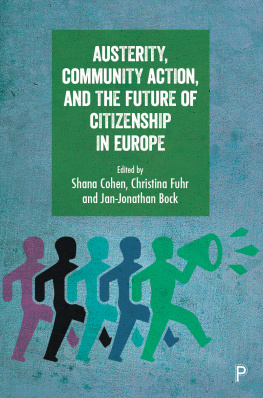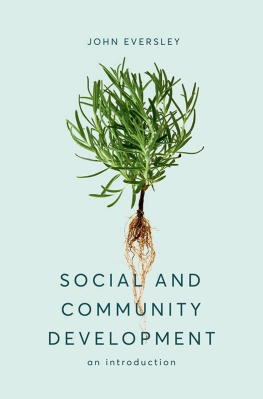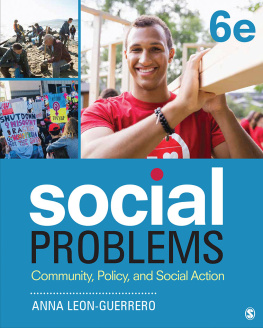First published in Great Britain in 2008 by
Policy Press
University of Bristol
6th Floor
Howard House
Queens Avenue
Clifton
Bristol BS8 1SD
UK
e-mail
www.policypress.co.uk
North American office:
Policy Press
c/o The University of Chicago Press
1427 East 60th Street
Chicago, IL 60637, USA
e:
www.press.uchicago.edu
Liz Richardson 2008
British Library Cataloguing in Publication Data
A catalogue record for this book is available from the British Library.
Library of Congress Cataloging-in-Publication Data
A catalog record for this book has been requested.
ISBN 978 1 84742 084 8 paperback
ISBN 978 1 84742 085 5 hardcover
The right of Liz Richardson to be identified as author of this work has been asserted by her in accordance with the 1988 Copyright, Designs and Patents Act.
All rights reserved: no part of this publication may be reproduced, stored in a retrieval system, or transmitted in any form or by any means, electronic, mechanical, photocopying, recording, or otherwise without the prior permission of The Policy Press.
The statements and opinions contained within this publication are solely those of the author and not of The University of Bristol, or The Policy Press. The University of Bristol and The Policy Press disclaim responsibility for any injury to persons or property resulting from any material published in this publication.
The Policy Press works to counter discrimination on grounds of gender, race, disability, age and sexuality.
Cover design by Qube design Associates, Bristol.
Front cover: photograph kindly supplied by www.thirdavenue.co.uk
Printed and bound in Great Britain by Henry Ling Ltd, Dorchester.
Readers Guide
This book has been optimised for PDA.
Tables may have been presented to accommodate this devices limitations.
Image presentation is limited by this devices limitations.
This book is about what people in low-income neighbourhoods are doing to improve the places where they live. It is about why they put themselves forward as volunteers, what they are able to achieve and how. It is about how residents and service providers can work together. Most importantly, it is about how Do-It-Yourself community action fits into the bigger picture of work by local and central government and others on neighbourhood renewal, community building and social inclusion. And it is about how more formal organisations can help support the creation and development of community self-help activity.
The core material on which the book is based is drawn from in-depth group interviews with around 300 community volunteers working in 82 deprived neighbourhoods across England and Wales. Contact was made with these community groups, and hundreds of others, through a five-year experimental national programme, called the Gatsby Training and Small Grant Project, which was designed to stimulate and facilitate community self-help action in low-income neighbourhoods.
DIY community action
In this book the term DIY community action is used interchangeably with community self-help activity and is taken to mean: informal groups of people, acting on a voluntary basis, working together to solve common problems by taking action themselves, and with others . While much community self-help is organised around neighbourhoods, it can also be organised around a shared concern across neighbourhoods. It is where people do something themselves to directly tackle problems. The scale of the activity might be modest, and could take the form of, for example, organising a youth disco, digging and planting a communal garden, hiring a coach for a social outing or running a community drop-in house.
Community self-help can (and should) have outside supporters it may even be initiated by outside agencies such as public sector bodies. But in essence, the groups members dictate the activity as a response to the needs of the wider community. It often involves residents working with the public sector, for example lobbying a social landlord or local council for better facilities. Community self-help is a form of community engagement people getting involved in decision making by the police, the planning department, or whoever. But, it involves more than residents commenting on what someone else should be doing.
The definition of DIY community action used here is about informal collective activity, although it is often difficult to say definitively where the informal ends and the formal begins. Formality increases by degree, rather than a jump. Some community groups have constitutions, others have legal structures, and some have neither. Some have paid staff, but most have no paid help. The Gatsby Training and Small Grant Project assessed whether community volunteers dominated decision making and did the bulk of the work, which was strongly linked to the size and scale of their operation and their financial turnover.
The importance of neighbourhood conditions
The community groups that were interviewed through the Gatsby Project talked about damaged and delicate neighbourhood conditions, about why community mattered to residents and how public service provision impacted on their lives. Active community volunteers talked about why they bothered and how people in poor areas felt they could help make things better. They talked about what success they had had, how the group related to the wider community, how their members worked together, what barriers they faced and what external support they valued.
Many of the problems, past and present, in the social housing estates where the groups members live demonstrate the importance of how poor neighbourhoods are managed. The residents gave examples to illustrate what could happen when management organisations performed badly, and their concerns chime strongly with the high political priority given to the ongoing task of improving the effective delivery of core public services. Given the scale of the task of improving public services, the study explored service users worries and problems, how organisational culture affected how public services were delivered to the residents and what day-to-day ground-level jobs could make a difference to residents on the estates.
Social capital and community engagement
The study focused on geographical neighbourhoods, and the relationships between people within them. Community, embracing both the places where people live and the relationships between the people who live in those places, continues to be highly relevant for residents. Despite the many problems that people experience in deprived neighbourhoods, there are also positive signs of resilience, often described by residents as a community spirit. Such signs of community spirit include the existence of supportive friendship networks and community-led activity. These relationships and positive signs of valued social activity within neighbourhoods are forms of what has been called social capital, which refers to the shared resources that being able to work together, and get along together, gives to an area or group. Like other forms of capital such as human and financial capital, social capital is an asset for deprived areas, and in academic and policy circles there has been a renewed interest in the role played by social capital in peoples quality of life (Aldridge and Halpern, 2002; Babb, 2005). The 2000 Local Government Act gave local authorities a power to do anything that would improve the economic, social and environmental well-being of local communities. But talking about people getting along together in a neighbourhood may sound to some like an old-fashioned ideal or a modern piece of fluffy thinking is it an outmoded perspective to talk about community? A key motivator for the groups was their desire to see a stronger sense of community, and this study explores what kinds of communities they were trying to build, why community mattered to people and whether an emphasis on community meant that privacy and tolerance of difference were sacrificed.










